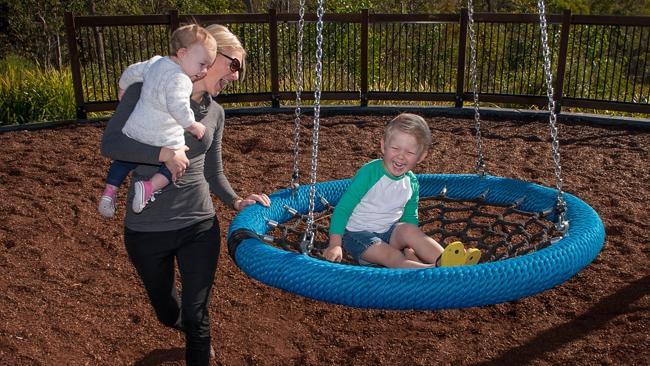Childcare fees v mum’s working future: why it’s no laughing matter
WOMEN are prepared for the huge cost of care, but places are few.

BUSINESSWOMAN Tara Platell counts the true cost of childcare in terms of her career.
A year-long waiting list for daycare was the last straw for the busy mother of two, who sold her real estate business in May to stay home with the kids when “it just got too much’’.
Three-year-old son Lachlan attends daycare two days a week but one-year-old Grace must wait until next year for a vacancy.
This week, Platell reluctantly knocked back a job offer because of problems finding full-time childcare in working-class Logan, to Brisbane’s south. She willingly would have paid the price of $76 a day — half her pay packet — to stay in the workforce.
A working-mother friend is so keen to keep a full-time job in the public service that she takes home a trifling $50 a week after coughing up the childcare fees for her two kids.
“Once you’re out of the workforce too long, it can be really difficult to get back in,’’ Platell reasons. “My predicament is: do I risk it, and in five years’ time look for another job, or do I work now?’’
This daycare dilemma lies at the heart of the childcare review conducted by the Productivity Commission, which has recommended revolutionary changes to a cumbersome and costly system.
The commission wants simpler subsidies for families, and lower qualifications for childcare workers looking after babies and toddlers, to douse the ever-escalating costs to parents and taxpayers.
Government subsidies should cover nannies, the commission says in its draft report, to make childcare more flexible for shiftworkers and more affordable for larger families.
The Abbott government is likely to support the reforms, with Assistant Education Minister Sussan Ley calling for “a modern system that supports today’s 24/7 economy, not the 9-5 working week of last century’’.
“People are designing their work lives around childcare, not childcare around their working lives, and that is a huge problem,’’ Ley told Inquirer yesterday.
“The system is a dog’s breakfast. The administrative complexity has become a nightmare for centres. We’ve also got to make the system more flexible so we can provide the type of care parents want, in the locations they want, at the hours they want.’’
Childcare costs have ballooned across the past decade, from 0.8 per cent of total federal government expenditure to 1.7 per cent last financial year. Spending will total a record $31 billion across the next four years.
Taxpayers are picking up the tab for two-thirds of the cost of approved childcare through a convoluted system of subsidies, which increase automatically as centres jack up their fees. Families pay the rest; out-of-pocket costs now soak up 27 per cent of the average wage — much more than the OECD average of 17 per cent.
The biggest bill to government is the means-tested Child Care Benefit, which subsidises childcare fees for low and middle-income families. The top rate is paid to families earning less than $43,000 a year, reducing until it cuts out at a $155,000 income for a family with two children.
On top of the CCB, all families receive the Child Care Rebate, which refunds half the remaining childcare bill, to a maximum of $7500 per child a year. A family with two children can get $15,000 a year towards childcare in the open-ended “cashback” scheme, regardless of how much they earn.
The Productivity Commission wants to replace the twin-subsidy scheme with a new early care and learning subsidy, paid directly to childcare centres rather than the parents. Ley says a single payment “makes sense’’.
Under the preferred model, the government would subsidise 90 per cent of childcare costs for a family earning less than $60,000 a year. As families earn more, subsidies would reduce, to cover 30 per cent of costs for a family earning more than $300,000.
Both parents would need to work or study for at least 24 hours a fortnight to qualify for government subsidies. Disadvantaged children — indigenous kids, refugees and those with a disabled parent or sibling — would attract higher payments.
For the first time, parents would be able to claim the subsidy to hire a nanny at home, subject to the same qualifications and regulations as daycare workers.
The commission also recommends the government extend backpacker visas from six months to 12 months to encourage parents to hire live-in foreign au pairs on working holidays.
Significantly, the subsidy would apply only to the “deemed cost’’ of delivering a service — $7.53 an hour for long daycare — set by the government to reflect the “reasonable cost’’ of operating a no-frills yet high-quality childcare service. Parents would have to pay any difference between the deemed cost and the actual cost charged by a centre offering, for example, valet parking, language lessons and Zumba classes.
This radical reform means parents would no longer get subsidies linked to the real cost of care, which can vary wildly based on the location and quality of a service.
Ley and the Productivity Commission agree the proposal needs tweaking so parents are not penalised for paying higher fees in Sydney and Melbourne. “I know that’s a challenge,’’ Ley says of the geographical differences in fees. “I look at rural areas, where childcare costs $65 a day, and in cities … it’s $120 or $130 a day.’’
Centres would continue to be able to charge higher fees for babies, who cost twice as much to care for as older children, because of higher staffing ratios. But given that every child would attract the same standard subsidy, parents would face much higher out-of-pocket costs for babies and toddlers than for preschoolers.
The commission says it is “mindful’’ that parents’ need for childcare does “not impact on child development’’. “An assistance arrangement which enabled working parents to use care for very young children, at a low cost for an unlimited number of hours per week, would be unlikely to be generally beneficial to child development,’’ it notes.
Australian Childcare Alliance president Gwynn Bridge says the existing paid parental leave scheme, which pays new mums the minimum wage for 18 weeks, has already drained demand for baby places. “We’re not seeing so many babies aged zero to eight months,’’ she says. “That’s not a bad thing — it’s good for bubs to be with their mums at that point.’’
The commission report pours cold water on the Abbott government’s contentious plan to expand the scheme so new mothers are paid their full salary for six months, capped at a total payment of $50,000. It argues that the money would be better spent on childcare, which is “a greater barrier to returning to work for mothers than the availability of PPL’’.
However, the commissioner who presided over the childcare inquiry, Wendy Craik, concedes that an expanded PPL scheme will entice more mothers to stay home longer with tiny babies. “It would reduce demand for the babies (in daycare),’’ she told Inquirer.
“It’s true it would enable the mother to look after the children at home and that is a real positive for the children, and not putting strain on childcare centres. Our view was that if the quality of care is of a higher standard than it is at home, then childcare can be beneficial. But if they’re too young or too long in care, that can have negative effects.’’
Ley insists the government will press ahead with its $5.5bn PPL scheme, to be funded through $2bn in taxpayer subsidies plus a 1.5 per cent levy on the country’s biggest companies.
Another bone of contention is the commission’s recommendation to unwind the so-called “creeping credentialism” of requiring higher-paid diploma and degree-qualified staff to care for babies and toddlers. “Nurturing, warm and attentive carers’’ are most important for little children, it says, while university-educated teachers are more appropriate for the older preschoolers.
Bridge, however, scoffs at this as “fairyland’’: “We’ve worked towards getting highly qualified staff and we don’t want to go backwards.’’
Craik recognises that childcare is a “cost of working’’, yet has ruled out tax deductions for childcare fees as a work-related expense. She says tax breaks would only benefit high-income earners, while exposing the government to open-ended expense.
Subsidising wealthy families for childcare is “contentious’’, the commission says in its draft. It is “actively exploring’’ a plan to cut off subsidies to families earning more than $300,000, for inclusion in its final report, due in October.
Craik believes many professional women will use childcare regardless of the cost, which can rival private-school fees for full-time care. “A lot of women who earn high incomes and are well-educated do often continue working, even though the returns are not so great, because they know over the longer term they will earn more if they stay in the workforce,’’ she says.
Ley, however, hints that the government will retain subsidies for wealthier families. “No matter what your income, affordability is a problem,’’ she argues. “Generally, the high and increasing cost of childcare is restricting parents’ participation in the workforce.’’
The Productivity Commission report estimates that 165,000 parents would like to work — or work longer hours — if only they could find a childcare place. It predicts its proposed reforms would lure 46,700 mothers back to work.
Sex Discrimination Commissioner Elizabeth Broderick views childcare as crucial if women are to achieve equality in the workplace. “Having access to affordable childcare for families is a central piece of social infrastructure which needs reform,’’ she insists. “Childcare is not a women’s issue. It’s everyone’s issue.’’



